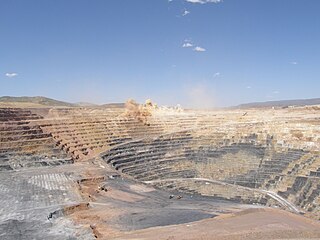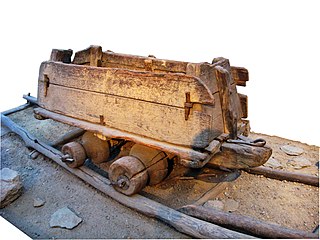
Mining is the extraction of valuable geological materials from the Earth and other astronomical objects. Mining is required to obtain most materials that cannot be grown through agricultural processes, or feasibly created artificially in a laboratory or factory. Ores recovered by mining include metals, coal, oil shale, gemstones, limestone, chalk, dimension stone, rock salt, potash, gravel, and clay. The ore must be a rock or mineral that contains valuable constituent, can be extracted or mined and sold for profit. Mining in a wider sense includes extraction of any non-renewable resource such as petroleum, natural gas, or even water.

Ore is natural rock or sediment that contains one or more valuable minerals concentrated above background levels, typically containing metals, that can be mined, treated and sold at a profit. The grade of ore refers to the concentration of the desired material it contains. The value of the metals or minerals a rock contains must be weighed against the cost of extraction to determine whether it is of sufficiently high grade to be worth mining, and is therefore considered an ore. A complex ore is one containing more than one valuable mineral.

Underground hard-rock mining refers to various underground mining techniques used to excavate "hard" minerals, usually those containing metals, such as ore containing gold, silver, iron, copper, zinc, nickel, tin, and lead. It also involves the same techniques used to excavate ores of gems, such as diamonds and rubies. Soft-rock mining refers to the excavation of softer minerals, such as salt, coal, and oil sands.

Muhlenberg County is a county in the U.S. Commonwealth of Kentucky. As of the 2020 census, the population was 30,928. Its county seat is Greenville and its largest city is Central City.

Iron ores are rocks and minerals from which metallic iron can be economically extracted. The ores are usually rich in iron oxides and vary in color from dark grey, bright yellow, or deep purple to rusty red. The iron is usually found in the form of magnetite (Fe
3O
4, 72.4% Fe), hematite (Fe
2O
3, 69.9% Fe), goethite (FeO(OH), 62.9% Fe), limonite (FeO(OH)·n(H2O), 55% Fe) or siderite (FeCO3, 48.2% Fe).

Open-pit mining, also known as open-cast or open-cut mining and in larger contexts mega-mining, is a surface mining technique of extracting rock or minerals from the earth from an open-air pit, sometimes known as a borrow.

Mining in the engineering discipline is the extraction of minerals from underneath, open pit, above or on the ground. Mining engineering is associated with many other disciplines, such as mineral processing, exploration, excavation, geology, and metallurgy, geotechnical engineering and surveying. A mining engineer may manage any phase of mining operations, from exploration and discovery of the mineral resources, through feasibility study, mine design, development of plans, production and operations to mine closure.

The Comstock Lode is a lode of silver ore located under the eastern slope of Mount Davidson, a peak in the Virginia Range in Virginia City, Nevada, which was the first major discovery of silver ore in the United States and named after American miner Henry Comstock.
Drift mining is either the mining of an ore deposit by underground methods, or the working of coal seams accessed by adits driven into the surface outcrop of the coal bed. A drift mine is an underground mine in which the entry or access is above water level and generally on the slope of a hill, driven horizontally into the ore seam. Random House dictionary says the origin of the term "drift mine" is an Americanism, circa 1885–1890.

The Southeast Missouri Lead District, commonly called the Lead Belt, is a lead mining district in the southeastern part of Missouri. Counties in the Lead Belt include Saint Francois, Crawford, Dent, Iron, Madison, Reynolds, and Washington. This mining district is the most important and critical lead producer in the United States.

Harmony Gold is the largest gold mining company in South Africa. Harmony operates in South Africa and in Papua New Guinea. The company has nine underground mines, one open-pit mine and several surface operations in South Africa. In Papua New Guinea, it has Hidden Valley, an open-pit gold and silver mine and a 50% interest in the Morobe Mining Joint Venture, which includes the Wafi-Golpu project and extensive exploration tenements. Outside the joint venture, Harmony's own exploration portfolio focuses principally on highly prospective areas in Papua New Guinea.
Princess is a small unincorporated community in Boyd County, Kentucky, United States.
Swedeland is a small unincorporated community that is located in Upper Merion Township, Montgomery County, Pennsylvania, United States, in the suburbs of Philadelphia.

Kentucky Camp is a ghost town and former mining camp along the Arizona Trail in Pima County, Arizona, United States, near the community of Sonoita. The Kentucky Camp Historic District is listed on the National Register of Historic Places and has been since 1995. As it is located within Coronado National Forest, the United States Forest Service is responsible for the upkeep of the remaining buildings within the Kentucky Camp Historic District.
Cleveland-Cliffs Inc., formerly Cliffs Natural Resources, is a Cleveland, Ohio-based company that specializes in the mining, beneficiation, and pelletizing of iron ore, as well as steelmaking, including stamping and tooling. It is the largest flat-rolled steel producer in North America.
Swift's silver mine is an alleged silver mine whose existence is part of the folklore of the Appalachian Mountains. The mine was supposedly discovered in 1760 by an Englishman named Jonathan Swift. The uncertainty of its location is part of the folklore of its existence, with locations ascribed to eastern Kentucky, southwest Virginia or eastern Tennessee.

A minecart, mine cart, or mine car is a type of rolling stock found on a mine railway, used for moving ore and materials procured in the process of traditional mining. Minecarts are seldom used in modern operations, having largely been superseded in underground operations by more efficient belt conveyor systems that allow machines such as longwall shearers and continuous miners to operate at their full capacity, and above ground by large dumpers.

Ferrexpo plc is a Swiss-based commodity trading and mining company which is the third largest exporter of iron ore pellets in the world. Ferrexpo's operating base is in central Ukraine, where it operates three iron-ore mines and an iron ore pellet production facility. The company's trading office is located in London where it is listed on the London Stock Exchange and it is a constituent of the FTSE 250 Index and FTSE4Good Index.

Uranium Corporation of India (UCIL) is a public sector undertaking (PSU), under the Department of Atomic Energy for uranium mining and processing. The corporation was founded in 1967 and is responsible for the mining and milling of uranium ore in India. The firm operates mines at Jadugora, Bhatin, Narwapahar, Turamdih and Banduhurang

Millerite is a nickel sulfide mineral, NiS. It is brassy in colour and has an acicular habit, often forming radiating masses and furry aggregates. It can be distinguished from pentlandite by crystal habit, its duller colour, and general lack of association with pyrite or pyrrhotite.

















